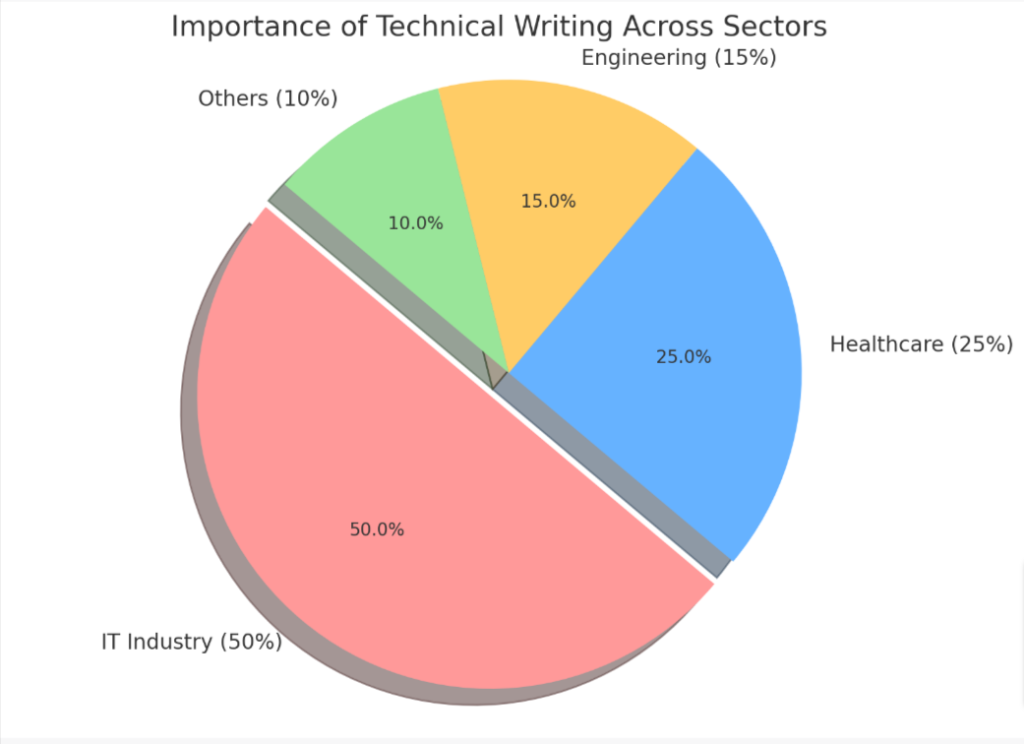Simplifying the Intricate: The Lucrative Realm of Technical Writing
Ever wondered how tech giants translate intricate concepts into simple language? Fact is, the IT industry heavily relies on efficient technical writing to convey complex information.
In this blog post, we’ll reveal secrets of successful technical communication used in top-notch companies worldwide. Dive in and discover how breaking down complex ideas can lead to big bucks!
Key Takeaways
- Effective technical writing is crucial in the IT industry and for clear communication of complex ideas.
- Tips for communicating complex ideas clearly include knowing your audience, choosing key concepts, providing context and examples, and using simple language.
- Tools for success in technical writing include analogies and storytelling, leveraging thinking patterns, creating visual aids, and leaving room for sense-making.
Understanding the Importance of Effective Technical Writing
Effective technical writing is crucial in the IT industry and for clear communication of complex ideas.
In IT industry
Technical writing plays an influential role in the IT industry. It involves creating detailed manuals, user guides, and various documentation that helps customers understand how to use a product or service effectively.
This field demands proficiency in translating technical lingo into language that non-tech individuals can easily comprehend. To make this content organized and user-friendly, companies rely on specific tools like diagrams and flowcharts.
Therefore, possessing strong technical writing skills can lead to lucrative career paths within the IT sector.
For clear communication of complex ideas
Technical writing serves as a vital bridge between complicated concepts and those who need to understand them. With precise language, measured descriptors, and simplified explanations, tech writers can break down complex ideas into digestible chunks.
This isn’t limited to the IT industry; this style of communication can be applicable in fields ranging from healthcare to aerospace engineering. Whether translating dense material or creating efficient documentation, the goal remains constant – making tricky concepts easy for anyone to grasp.
Through these practices, technical writing helps in communicating complex information successfully.

Tips for Communicating Complex Ideas Clearly
Know your audience and choose the key concept to focus on, providing context and examples using simple language for better comprehension.
Know your audience
Understanding your audience plays a crucial role in technical writing. It shapes how you present information, from the level of detail to the use of industry jargon. For instance, if your readers are experts in the field, they can likely handle more complex concepts and terminology.
However, if you’re writing for non-specialists or newcomers to the field, it’s essential to break down complicated ideas into simple terms and definitions they’ll understand. This approach ensures every reader feels included and is able to grasp even complex ideas easily.
Choose the key concept
To effectively communicate complex ideas in technical writing, it is crucial to choose the key concept and focus on it. By selecting the most important point or idea, you can streamline your message and make it easier for your audience to understand.
This means identifying the core information that needs to be conveyed and organizing your content around it. By doing so, you can eliminate unnecessary details and provide a clear and concise explanation of the subject matter at hand.
When you choose the key concept, you simplify complex ideas and ensure that your readers grasp the main point without getting lost in a sea of information.
Provide context and examples
Context and examples are essential components of effective technical writing. They help to clarify complex ideas and make them more understandable for the audience. Here are some tips on how to provide context and examples:
- Set the stage: Begin by providing a brief overview of the topic or concept you are explaining. This helps to establish the context for your readers and gives them a foundation to build upon.
- Use real-world scenarios: Provide examples that relate to everyday situations or common experiences. This helps your audience connect with the information and see its relevance in their own lives.
- Break it down step by step: If you’re explaining a process or procedure, use a series of clear and concise steps to guide your readers through it. Break down complex tasks into manageable chunks, making it easier for them to follow along.
- Utilize visuals: Visual aids such as diagrams, charts, or infographics can greatly enhance understanding. Use these tools to illustrate concepts, show relationships between different elements, or highlight key points.
- Draw comparisons: Analogies can be a powerful way to explain complex ideas by comparing them to something more familiar. Find relatable examples or metaphors that can help your audience grasp the underlying concept.
- Provide supporting evidence: When presenting complex information, back it up with data, research findings, or expert opinions. This adds credibility and helps readers trust the information you are providing.
- Anticipate questions and address potential confusion: Put yourself in the shoes of your audience and think about what they might find confusing or unclear. Address these potential roadblocks upfront by providing additional explanations or clarifications.
Use simple language
Use simple language to effectively communicate complex ideas. When writing technical content, it’s important to use clear and concise language that is easily understandable by your audience.
Avoid using jargon or technical terms that may confuse readers. Instead, opt for plain and straightforward language that conveys your message accurately. By using simple language, you can break down complicated concepts and make them more accessible to your readers.
This not only enhances comprehension but also ensures effective communication of technical information. Keep in mind the readability level of your target audience and strive for clarity in your writing.
Tools for Success in Technical Writing
To effectively communicate complex ideas, technical writers can utilize powerful tools such as analogies and storytelling, thinking patterns, visual aids, and allowing room for sense-making.
These tools not only simplify complicated concepts but also engage readers in understanding the material. Want to learn more about how these tools can elevate your technical writing skills? Read on!
Analogies and storytelling
Analogies and storytelling are powerful tools in technical writing. They help to simplify complex ideas by comparing them to something familiar or using narrative techniques. By using analogies, readers can make connections between new concepts and those they already understand.
This makes it easier for them to grasp and remember the information being presented. Similarly, storytelling engages readers on an emotional level, helping them relate to the subject matter more effectively.
Incorporating analogies and storytelling into technical writing enhances comprehension, making it a valuable skill for tech writers seeking to communicate complex ideas clearly and concisely.
Leveraging thinking patterns
To effectively communicate complex ideas, leverage thinking patterns by:
- Identifying logical connections and relationships between concepts.
- Utilizing problem – solving strategies to break down complex ideas into manageable components.
- Applying critical thinking skills to analyze and evaluate information.
- Using creative thinking techniques to generate innovative solutions.
- Incorporating cognitive frameworks to organize and structure information.
- Adapting thinking patterns to match the mindset of your audience.
- Employing strategic questioning to prompt deeper understanding and reflection.
- Encouraging divergent thinking to explore multiple perspectives and possibilities.
Creating visual aids
Creating visual aids is an effective way to convey complex ideas in technical writing. Visuals can enhance comprehension and make information easier to understand. Here are some ways you can create compelling visual aids:
- Infographics: Use colorful and engaging infographics to present data, statistics, or processes in a visually appealing manner.
- Charts and graphs: Presenting numerical data in the form of charts or graphs can help readers grasp complex concepts quickly.
- Diagrams: Visualize processes, systems, or relationships using diagrams. Flowcharts, Venn diagrams, or network diagrams can simplify complex ideas.
- Illustrations: Use illustrations or drawings to provide clarity and simplify complicated concepts that may be difficult to explain with words alone.
- Screenshots: Including screenshots of software interfaces or step-by-step procedures can guide readers through technical instructions.
- Tables: Organize information into tables to present complex data sets or comparisons in a structured and easily digestible format.
- Icons and symbols: Incorporate icons and symbols to represent actions, categories, or concepts, making it easier for readers to recognize and understand information.
- Mind maps: Create visual mind maps to outline connections between ideas and organize information hierarchically.
Leaving room for sense-making
To effectively communicate complex ideas in technical writing, it is crucial to leave room for sense-making. This means providing enough information and context for the audience to understand and make sense of the material presented.
By breaking down complicated concepts into manageable chunks and offering clear explanations, tech writers can enable readers to grasp and interpret the information more easily. Leaving room for sense-making allows for a smoother flow of comprehension, ensuring that the intended message comes across clearly to the target audience.
Conclusion
Mastering the art of technical writing and effectively breaking down complex ideas can lead to lucrative opportunities in the IT industry. By understanding your audience, choosing key concepts, providing context and examples, and using simple language, you can communicate technical information with precision and clarity.
Don’t miss out on the potential for big bucks by honing your skills in this valuable field!

